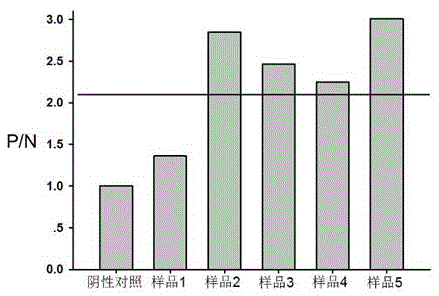Polypeptide-ELISA kit for detecting specific antibody against envelope glycoprotein of severe fever with thrombocytopenia syndrome virus
An enzyme-linked immunosorbent adsorption and virus envelope technology, applied in the biological field, can solve the problems of long neutralization test cycle, poor sensitivity and specificity, and high requirements for operators, so as to improve detection accuracy, strong specificity, and reduce false positives. positive effect
- Summary
- Abstract
- Description
- Claims
- Application Information
AI Technical Summary
Problems solved by technology
Method used
Image
Examples
Embodiment 1
[0034] Example 1: Preparation of predominant linear B cell antigen polypeptides of the envelope glycoproteins (Gn, Gc) of fever with thrombocytopenia syndrome virus
[0035] According to the characteristics of linear B cell epitopes of strong antigenicity, good surface and strong hydrophilicity, bioinformatics software is used to analyze the amino acid sequence of the envelope glycoprotein (Gn and Gc) of fever with thrombocytopenia syndrome virus, and predict and determine The dominant linear B cell epitope site on the viral envelope glycoprotein. Artificially synthesized 13-segment peptides containing linear B cell epitope sites of Gn and Gc proteins: RGGRSQVSYYPAENSYSR, GKSRTES, REHKTKWVQESSS, SESEEKAC, VNPPEQR, SSGKKSTEIHFH, NGEGNQDDVR, and KCKKSERSSS, EQKSKK, NSSEESSTA on Gc , QVFRSRTKLA, the purity after purification is more than 95%.
Embodiment 2
[0036] Example 2: Preparation of an ELISA plate pre-coated with polypeptide antigen
[0037] Use the synthesized peptides as antigens and dilute them to 10 μg / ml with coating buffer. Take 1 ml of the peptide solution and mix them. After mixing, coat 100 μl / well in a 96-well microtiter plate. , Wash the plate 3 times after overnight at 4°C. Add 200 microliters of phosphate buffer containing 1% bovine serum albumin to each well for sealing, incubate at 37°C for 1 hour, wash the plate 3 times, dry it, seal the ELISA plate in a sealed bag, and store it at 4°C for later use.
[0038] The solution formula is as follows:
[0039] Coating buffer (0.05 mol / L carbonate buffer, pH 9.6): add to 1000 ml of distilled water
[0040] 1.59 grams of sodium carbonate (Na 2 CO 3 ) And 2.93 grams of sodium bicarbonate (NaHCO 3 ), dissolve and mix well.
[0041] Phosphate buffer (0.01mol / L PBS, pH7.4): add 8.0 g of sodium chloride (NaCl), 0.2 g of potassium dihydrogen phosphate (KH 2 PO 4 ), 2.9 grams of d...
Embodiment 3
[0043] Example 3: Preparation of other solutions in the kit
[0044] Sample diluent: 1% bovine serum albumin and 0.1% Tween-20 were added to PBS, pH 7.4.
[0045] Enzyme-labeled antibody: HRP-labeled antibody, commercially available, diluted 5000 times with sample diluent for use.
[0046] Concentrated washing solution: 100 mmol / L PBS containing 1% Tween-20, pH 7.4, diluted 10 times when washing.
[0047] Enzyme substrate A solution: 5.1 grams of citric acid (C 6 H 8 O 7 ·H 2 O), 18.4 grams of disodium hydrogen phosphate (Na 2 HPO 4 ·12H 2 O), add water to make the volume to 1000 ml and mix well.
[0048] Enzyme substrate B solution: 1 ml of 30% hydrogen peroxide.
[0049] Enzyme substrate C: 1 gram of o-phenylenediamine (OPD) powder.
[0050] Stop solution: 2 mol / L sulfuric acid solution, add 108.7 ml of 98% concentrated sulfuric acid to 891.3 ml of water, mix and cool.
PUM
 Login to View More
Login to View More Abstract
Description
Claims
Application Information
 Login to View More
Login to View More - Generate Ideas
- Intellectual Property
- Life Sciences
- Materials
- Tech Scout
- Unparalleled Data Quality
- Higher Quality Content
- 60% Fewer Hallucinations
Browse by: Latest US Patents, China's latest patents, Technical Efficacy Thesaurus, Application Domain, Technology Topic, Popular Technical Reports.
© 2025 PatSnap. All rights reserved.Legal|Privacy policy|Modern Slavery Act Transparency Statement|Sitemap|About US| Contact US: help@patsnap.com


